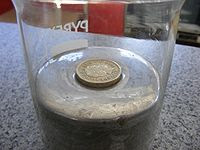Floating or sinking dramatically depends on the comparative differences between the two objects’ density. Density refers to how much space a substance or object takes, or its volume, as compared to the amount of matter present in that substance or object, or its mass. To put it simply, density pertains to the amount of mass in a particular space. Elements sitting at the top of the periodic table possess lower densities. Meanwhile, those placed on the bottom have higher densities.
When discussing density, mercury is the best element to use for citing how density plays its role in how things float or sink. You might be surprised that massive objects, such as iron bars or dumbbells that sinks typically in water, can float in large amounts of mercury. But how does it does so?
Generally, the item with the lesser density floats, while the material with the higher density sinks. Based on Archimedes’ principle, any material that is put on a liquid will displace a part of the fluid. Now, the supplanted part of the liquid then creates a buoyant force directly proportional to the object’s weight. If the buoyant force is stronger than the material’s weight, then it will float. However, if the buoyant force is weaker, it cannot hold the item, making it sink.
Truth to be told, mercury has a high density. The metallic element actually boasts a density of around 13.5 grams per cubic centimeter, making it 13 times more potent than of water, which is at 1 gram per cubic centimeter. Meanwhile, iron sits in the middle, with a density of 7.87 grams per cubic centimeter. Through that, we can infer that iron is denser than water. Therefore, it sinks. But, mercury is heavier than iron, which is why iron floats in mercury.
But, objects like sponges, wood, and apples have less density than water, so they will easily float. Empty bottles, balloons, balls also float are they are brimmed with air, which is less dense than water.
Mercury is highly-dense, so some objects you might deem heavy, like steel ball bearing or weights, will actually float in it. Such other metals, like copper and nickel, organic materials, such as plastics, wood, and stones, and gases and liquid, which are lens dense than mercury, will also float in it.
While it may seem strong, there are other metallic elements, which have a higher density than mercury, will sink through it. Some of these include iridium with a density of 22.65 grams per cubic centimeter, platinum at 21.4, and gold with 19.3. Most of the radioactive substances called actinide elements won’t also float in mercury. Uranium has a density of 19.1 gram per cubic centimeter, neptunium has 20.45, while lawrencium has 16.6.
You might be wondering if you can float on mercury. Well, taking pure density into account, you would float on large amounts of metallic mercury. That is because the human body is composed of around 65-80% of water, making less dense than mercury. Remember, the object will lower density would always float, or remain buoyant and not sink, on top the substance that it heavier or with higher density.
More Readings:
Iron (Wikipedia)
Mercury (element) (Wikipedia)
You Might Also Like:

